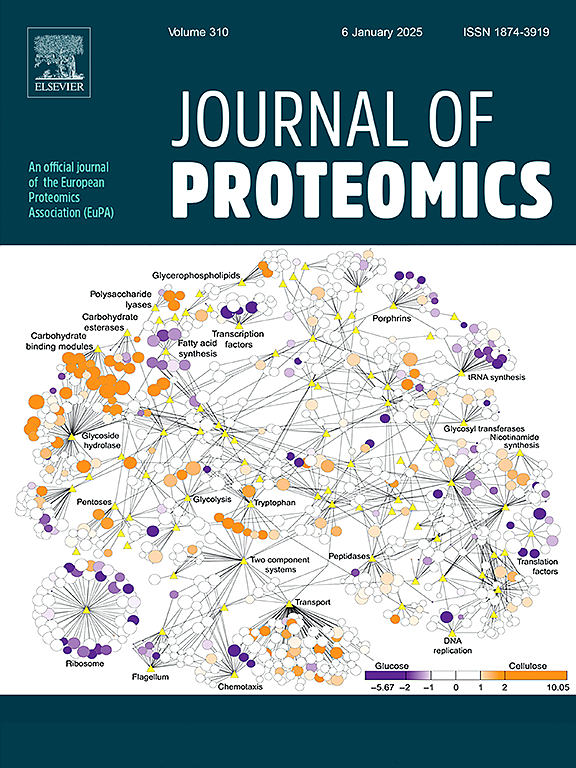Proteomic profiling of over 13,000 proteins across ten mouse tissues using multi-dimensional peptide pre-fractionation
IF 2.8
2区 生物学
Q2 BIOCHEMICAL RESEARCH METHODS
引用次数: 0
Abstract
Proteome-wide abundance profiling across tissues can provide insight into the biological mechanisms underlying tissue-specific function, as well as potential related dysfunction and amelioration thereof. Here, we use sample multiplexing to profile the proteomes of ten diverse mouse tissues using quantitative mass spectrometry-based sample multiplexing. Our optimized workflow, incorporating two-dimensional peptide pre-fractionation (which included both basic pH reversed-phase and strong ion exchange chromatography) enabled the quantification of over 13,000 proteins across brain, brown fat, heart, kidney, liver, lung, skeletal muscle, spleen, ovaries, and testes. Global analysis revealed distinct proteome profiles for each tissue, with clear clustering patterns reflecting functional similarities and differences. We highlighted the abundance of numerous tissue-specific proteins, exemplified by Synapsin-1 in brain, Uncoupling protein 1 in brown fat, and Zona pellucida proteins in reproductive tissues. Gene ontologies and pathway analyses of the most relatively abundant proteins in each tissue revealed enrichment patterns consistent with known physiological functions. For instance, brain tissue showed enrichment for synaptic components and neurotransmission processes, while liver tissue was enriched for metabolic pathways. This dataset serves as a valuable resource for mapping tissue-specific protein landscapes in mammals, offering potential insights into the molecular mechanisms of tissue function.
Significance
We present a proteome-wide analysis of ten diverse mouse tissues using an optimized TMTpro-based quantitative mass spectrometry workflow. This workflow is enhanced by two-dimensional peptide pre-fractionation with strong anion exchange partitioning followed by basic pH reversed-phase chromatography. By quantifying over 13,000 proteins, we provide an unprecedented dataset revealing distinct tissue-specific protein abundance profiles and their alignment with known physiological functions. This dataset as a resource offers valuable insights into the molecular underpinnings of tissue-specific biology and establishes a foundation for future research into physiological processes, disease mechanisms, and therapeutic development in mammals.

使用多维肽预分离技术对十种小鼠组织中超过13,000种蛋白质进行蛋白质组学分析。
跨组织的蛋白质组丰度分析可以深入了解组织特异性功能和潜在相关功能障碍及其改善的生物学机制。在这里,我们使用样品多路复用,以定量质谱为基础的样品多路复用来分析十种不同小鼠组织的蛋白质组。我们优化的工作流程,结合二维肽预分离(包括碱性pH反相和强离子交换色谱),可以定量分析大脑、棕色脂肪、心脏、肾脏、肝脏、肺、骨骼肌、脾脏、卵巢和睾丸等超过13,000种蛋白质。全局分析揭示了每个组织不同的蛋白质组谱,清晰的聚类模式反映了功能的相似性和差异性。我们强调了许多组织特异性蛋白的丰度,例如大脑中的突触素-1,棕色脂肪中的解偶联蛋白1和生殖组织中的透明带蛋白。每个组织中最丰富的蛋白质的基因本体和途径分析揭示了与已知生理功能一致的富集模式。例如,脑组织显示突触成分和神经传递过程的富集,而肝脏组织则显示代谢途径的富集。该数据集为绘制哺乳动物组织特异性蛋白质景观提供了宝贵的资源,为组织功能的分子机制提供了潜在的见解。意义:我们使用优化的基于tmtpro的定量质谱工作流程对十种不同的小鼠组织进行了蛋白质组范围的分析。这一工作流程是加强了二维肽预分馏与强阴离子交换分配,然后是碱性pH反相色谱。通过量化超过13,000种蛋白质,我们提供了一个前所未有的数据集,揭示了不同的组织特异性蛋白质丰度特征及其与已知生理功能的一致性。该数据集作为一种资源,为组织特异性生物学的分子基础提供了有价值的见解,并为未来研究哺乳动物的生理过程、疾病机制和治疗开发奠定了基础。
本文章由计算机程序翻译,如有差异,请以英文原文为准。
求助全文
约1分钟内获得全文
求助全文
来源期刊

Journal of proteomics
生物-生化研究方法
CiteScore
7.10
自引率
3.00%
发文量
227
审稿时长
73 days
期刊介绍:
Journal of Proteomics is aimed at protein scientists and analytical chemists in the field of proteomics, biomarker discovery, protein analytics, plant proteomics, microbial and animal proteomics, human studies, tissue imaging by mass spectrometry, non-conventional and non-model organism proteomics, and protein bioinformatics. The journal welcomes papers in new and upcoming areas such as metabolomics, genomics, systems biology, toxicogenomics, pharmacoproteomics.
Journal of Proteomics unifies both fundamental scientists and clinicians, and includes translational research. Suggestions for reviews, webinars and thematic issues are welcome.
 求助内容:
求助内容: 应助结果提醒方式:
应助结果提醒方式:


